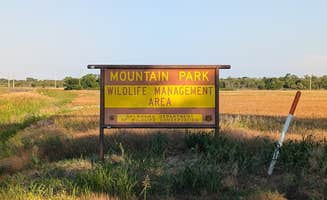Dispersed camping opportunities near Indiahoma, Oklahoma extend beyond the Tom Steed Reservoir area. The region offers primitive camping experiences with varying terrain and accessibility levels throughout the Wichita Mountains Wildlife Refuge and surrounding areas. Summer temperatures regularly exceed 95°F while winter nights can drop below freezing, requiring seasonal preparation. Most dispersed sites in this region lack designated boundaries and operate on a first-come basis.
What to do
Wildlife viewing opportunities: The Oklahoma Wildlife Management Area near Great Plains State Park Dispersed Campsite provides habitat for diverse wildlife. Campers report seeing deer, waterfowl, and small mammals particularly during dawn and dusk hours. "We spent a night here and it was beautiful. I loved the challenge to get to the spot," notes Pam H., who found the lakeside setting ideal for wildlife observation.
Fishing access: Tom Steed Reservoir contains multiple fish species including largemouth bass, crappie, and catfish. A valid Oklahoma fishing license is required ($25 for residents, $55 for non-residents). "Beautiful view of the mountain and lake. Very quiet and peaceful, and no other visitors," says Benjamin G., highlighting the undisturbed fishing conditions available.
Stargazing sessions: The minimal light pollution at primitive campsites creates excellent conditions for night sky viewing. Bring red-light headlamps to preserve night vision while moving around camp. The area's open terrain provides unobstructed views of constellations and occasional meteor showers, particularly during summer months.
What campers like
Budget-friendly options: Free camping near Indiahoma, Oklahoma appeals to budget-conscious travelers looking to minimize expenses. "The roads a little rough but it's free with great views," explains Joe L., emphasizing the value proposition of these no-fee sites despite access challenges.
Solitude and privacy: Dispersed camping areas around Indiahoma typically offer significant distance between informal campsites. The more difficult access roads naturally limit visitor numbers, creating quieter experiences than developed campgrounds. "Very quiet and peaceful, and no other visitors," Benjamin G. notes about his camping experience.
Natural settings: Primitive sites provide more immersive natural experiences without developed infrastructure. Campsites typically feature native grass areas adjacent to water features. Some locations offer panoramic views of nearby mountains and water bodies without designated boundaries or site markers.
What you should know
Navigation challenges: Finding the correct access points requires attention to landmarks rather than formal addresses. "These coordinates get you close to the road where the WMA begins. Look for the OK WMA sign and turn," advises Kevin S., clarifying important navigational details for first-time visitors to Waurika Lake Camp.
Road conditions vary seasonally: Spring rains can create deep mud sections that become impassable without high-clearance 4WD vehicles. Summer drought conditions harden these same roads but create dusty conditions. "The road is very rough, but we managed in our VW Atlas," explains Benjamin G., suggesting standard SUVs can access some areas during dry conditions.
Self-sufficiency requirements: All water, food, and emergency supplies must be transported in and waste packed out. No potable water sources exist at dispersed sites, requiring campers to bring 1-2 gallons per person per day depending on temperatures. Cell service ranges from spotty to non-existent depending on carrier and exact location.
Tips for camping with families
Site selection priorities: Choose areas away from steep drop-offs when camping with young children. Sites farther from water edges provide safer play zones but require water transportation for cooking and cleaning. "Coordinates will get you close to your turn but you have to watch for the sign," Pam H. explains about locating family-friendly spots.
Wildlife awareness: Teach children proper food storage practices to avoid attracting wildlife to campsites. All food should be secured in vehicles overnight rather than in tents. Snake awareness is particularly important during summer months when temperatures encourage reptile activity.
Entertainment planning: No recreational facilities exist at primitive sites, requiring families to bring all entertainment options. Popular activities include rock collecting, wildlife tracking, and simple fishing setups appropriate for various age groups.
Tips from RVers
Vehicle limitations: RV access to dispersed camping near Indiahoma requires careful assessment of vehicle specifications. "The road gets rough and has low hanging limbs that will hit tall vehicles," warns Kevin S. about conditions at the Oklahoma Wildlife Management Area. Trailers exceeding 20 feet generally cannot navigate the narrow access roads with tight turns.
Leveling requirements: Bring multiple leveling blocks as natural terrain rarely provides perfectly level parking. Most primitive sites require significant adjustment to achieve stable positioning. Scout potential parking areas on foot before attempting to position larger vehicles to avoid becoming stuck.


